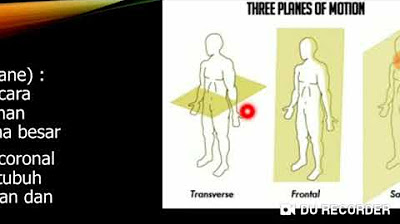EASY TRICKS for Anatomical Body Planes and Sections [Direction/Position]
Summary
TLDRThis educational video introduces the concept of anatomical position and body planes, essential for understanding human anatomy. It explains the standard anatomical position and clarifies the difference between body planes and sections. The script uses mnemonic devices like 'SCT' for sagittal, coronal, and transverse planes, and provides visual examples to distinguish between them. The video aims to simplify complex anatomical concepts, making them accessible for viewers interested in medical and scientific topics.
Takeaways
- 🧍 The standard anatomical position is an upright standing pose with arms at sides and palms forward, providing a universal reference for anatomy.
- 👁 When in anatomical position, 'right' and 'left' refer to the patient's sides, not the observer's perspective.
- ✂️ Body planes are imaginary lines that divide the body into sections for different views, aiding in the description of anatomical structures.
- 📏 The three main body planes are sagittal, coronal, and transverse, remembered by the abbreviation 'SCT'.
- 🟢 The sagittal plane divides the body into right and left sections, with the midsagittal plane being the exact middle.
- 🔵 The coronal plane, also known as the frontal plane, divides the body into front and back sections.
- 🟡 The transverse plane, or axial plane, divides the body into top and bottom sections, providing a top view of the body.
- 🤔 Longitudinal planes run perpendicular to the transverse plane, including both the sagittal and coronal planes.
- 💭 Oblique planes are any planes that are not horizontal or vertical, running at various angles through the body.
- 🗝️ The prefixes 'para-' and 'trans-' are associated with specific types of planes, indicating 'beside' and 'across' respectively.
- 📚 Understanding these planes and sections is crucial for describing the location and direction of anatomical features in medical studies.
Q & A
What is the standard anatomical position?
-The standard anatomical position is a body orientation used to describe anatomical planes, sections, and directional terms. It involves standing upright with the head and eyes directed straight ahead, upper limbs hanging down at the sides with palms facing forward, and lower limbs together with feet flat on the ground facing forward.
Why is the standard anatomical position important?
-The standard anatomical position is important because it provides a universal and consistent way of discussing anatomy, creating clear reference points when describing anatomical positions or using anatomical terms.
What is the difference between body planes and body sections?
-Body planes are imaginary lines drawn through an upright body in anatomical position that divide the body into sections or portions. Body sections, on the other hand, are the portions of the body created by the cut from the plane.
How many main body planes are there and what are they?
-There are three main body planes: the sagittal plane, the coronal plane, and the transverse plane.
What does the abbreviation 'SCT' stand for and how does it help in remembering the main body planes?
-The abbreviation 'SCT' stands for Sagittal, Coronal, and Transverse planes. It helps in remembering the order and the names of the three main body planes.
What is the midsagittal plane and how is it different from a parasagittal plane?
-The midsagittal plane is a specific sagittal plane that runs through the midline of the body, dividing it into equal right and left portions. It is also known as the median plane. A parasagittal plane, however, is any off-center sagittal plane that divides the body into unequal right and left portions and runs parallel to the midsagittal plane.
How can the terms 'sagittal' and 'side view' help in remembering the sagittal plane?
-The terms 'sagittal' and 'side view' both start with the letter 'S', which can help in remembering that when a cut is made through the sagittal plane, it provides a side view of the body.
What is the coronal plane and how does it divide the body?
-The coronal plane, also known as the frontal plane, is a vertical plane that runs from top to bottom and right to left, dividing the body into a front section and a back section.
What is the transverse plane and how does it provide a top view of the body?
-The transverse plane, also known as the axial or horizontal plane, is a horizontal line that runs from right to left and front to back, dividing the body into a top section and a bottom section, thus providing a top view of the body.
What are longitudinal planes and how are they related to the transverse plane?
-Longitudinal planes are any planes that are perpendicular to the transverse plane. Both the sagittal and coronal planes run perpendicular to the transverse plane, making them examples of longitudinal planes.
What is an oblique plane and how does it differ from the major body planes?
-An oblique plane is any plane that is not horizontal or vertical, meaning it does not fall into the categories of sagittal, coronal, or transverse planes. It can run at any angle through the body as long as it is not aligned with the major planes.
Outlines

此内容仅限付费用户访问。 请升级后访问。
立即升级Mindmap

此内容仅限付费用户访问。 请升级后访问。
立即升级Keywords

此内容仅限付费用户访问。 请升级后访问。
立即升级Highlights

此内容仅限付费用户访问。 请升级后访问。
立即升级Transcripts

此内容仅限付费用户访问。 请升级后访问。
立即升级浏览更多相关视频

ANATOMI GERAK MANUSIA (BAG. 1) : ISTILAH ARAH, BIDANG ANATOMIS DAN SUMBU ANATOMIS.

A&P I: chapter 1 orientation

Introduction Of Anatomy Sesi 2 - Putri Halleyana Adrikni Rahman, dr., M.Kes

Introduction à l’anatomie : Tout ce que vous devez savoir

Anatomie Grundlagen - Lagebezeichnungen und Ebenen am Körper einfach erklärt

Introdução à Anatomia: posição anatômica e termos de relação | Anatomia etc
5.0 / 5 (0 votes)
